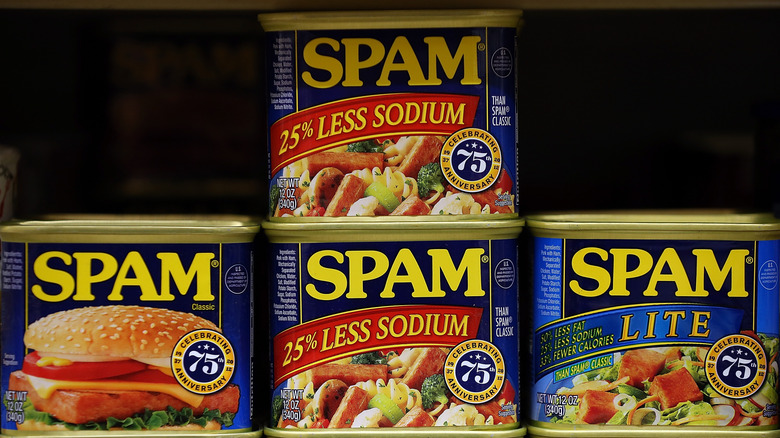
Justin Sullivan/Getty Images
Inflation — alongside other factors such as Russia's invasion of Ukraine and Trump's tariffs — has caused grocery prices to soar by 29% in the five years between 2020 and 2025 (via NPR). There's no sign of this letting up, so it's unsurprising that some vintage grocery items are making a comeback thanks to inflation. Ultimately, even if inflation goes down, this doesn't cause food prices to be cheaper — it just slows down how quickly they rise.
This means many households are looking for cheaper options at the supermarket, and oftentimes they end up with old school grocery items in their shopping cart. These are tried-and-true staples that people have been cooking with for generations. They might not be luxurious, but they're the building blocks of wholesome meals. From beans and other pulses to canned and dried products to pantry staples for baking, there are all kinds of foods and ingredients that were once forgotten and under-loved but are now having a moment. We'll go over these vintage groceries and how you might use them to stretch your budget further.
Canned beans
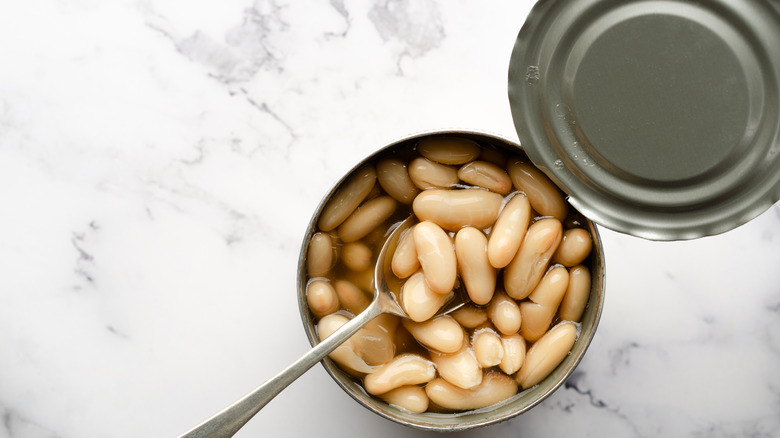
Cecilia Di Dio/Getty Images
There's a booming market for canned beans that has been rising in recent years and is only set to get bigger. While there are likely many reasons why sales are on the up — including a surge in people following vegan or vegetarian diets — one of the big ones is their affordable price. High in protein, beans can replace meat, tofu, or mock meats in recipes but cost a fraction of the price.
There are pros and cons of using canned beans. One of the great things about them is that they're ready to use right out of the can. With many bean varieties available, you can incorporate them into everything from pasta dishes to burritos to curries. You can also blend them into hummus, mash them and mix them with mayo as a sandwich topper, or toss them into a salad without ever having to turn on the stove. You can even upgrade canned beans with onions, garlic, spices, and various cooking techniques. They also last in your pantry for years, so they're ready for you when you need them. However, they're also less flavorful than beans cooked from scratch and can contain additives. They might be old school, but they still have a place in contemporary cooking.
Dried beans and pulses

Mediterranean/Getty Images
What's cheaper than filling out a meal with canned beans? Using dried beans or other pulses instead. People are eating more dried legumes — beans, peas, and lentils — and sales are expected to rise with a compound 5% growth rate over the next decade (via Expert Market Research). Although people might be turning to them to make their grocery dollars go further, they're a staple for a reason.
Dried beans work out significantly cheaper than canned beans. Sure, it takes more time and energy to cook them, but the tradeoff is worth it for many people. If you're new to dried pulses and you're not sure where to start, there are some expert techniques for cooking beans you need to try. Some people speed up the process by using a pressure cooker, whereas others do a hot soak to hurry things along. You could also opt to use lentils instead of beans since they cook significantly quicker. Then, there's the nutrition aspect. They're filled with protein and fiber, along with other nutrients that are essential for a healthy diet. Even if you start eating dried pulses as a cheap way to eat healthy food, you should soon be won over by their versatility and great flavor.
Canned pasta
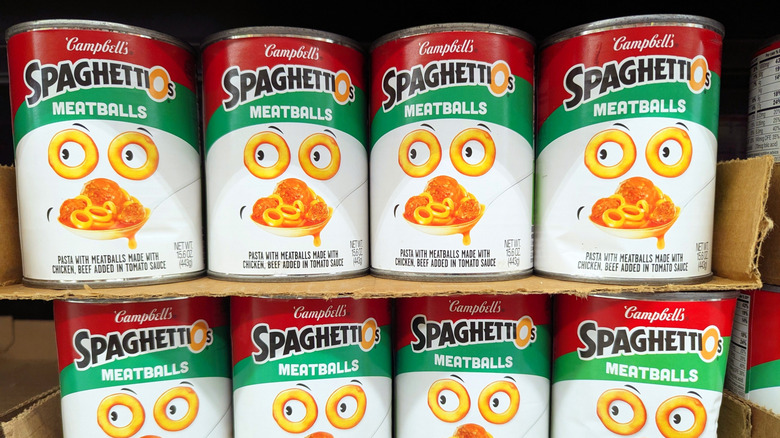
PJ McDonnell/Shutterstock
Canned pasta — such as SpaghettiOs or little tins of ravioli — might seem like a thing of the past. But, between 2018 and 2024, the canned pasta market grew by about $2 million dollars annually (via Credence Research). This is likely down to inflation and people going for cheap, familiar comfort foods.
Eating canned pasta on the reg might sound a bit bleak, but it doesn't have to be. There are plenty of ways to upgrade canned ravioli, such as making ravioli soup or frying it until crisp. You can even use it as a pizza topping if you want to get fancy. SpaghettiOs can be deliciously nostalgic as they are, but they're also easy to level up by adding aromatics, such as onions, garlic, herbs, and spices. Ultimately, some canned pasta is better than others, so if you choose to buy it, make sure you opt for quality. Sometimes a familiar name signals quality, but small brands have also got some great products. It's not always cheaper per serving than buying pasta and sauce, but the convenience is up there. Plus, when you're cooking for one, you have to pay out less in one go for a can versus all the ingredients to make a pasta dish from scratch.
Dried vegetables

Boyrcr420/Getty Images
Dried vegetables might seem like something out of wartime austerity, but they've increased in popularity in recent years. With huge increases on food prices due to inflation, people are looking for simple, affordable ways to add nutritious ingredients to food. Dried vegetables can be cheaper gram-for-gram, and they also save money by reducing food waste since, unlike fresh veggies, they don't spoil before you get around to using them.
Dried vegetables have a history of use in Chinese cooking. Products such as Vegeta combine dried vegetables with seasoning and are commonly found in Eastern European cuisine. Common dried vegetables found in supermarkets include sundried tomatoes (the dehydrated ones, not the oil-packed kind) and mushrooms. You can also sometimes find bags of mixed dehydrated veggies, depending on the store. You can rehydrate them in soups and stews, soak them in water and add them to pasta dishes or fried rice, or even grind them into a savory seasoning powder. Whatever you choose, there's room for this vintage favorite to make a comeback.
Canned fish

Horacio Villalobos/Getty Images
Rising sales of tinned fish may be a recession indicator — a warning sign of an economy about to get worse. And what do you know — online searches and canned fish sales are on the rise. This could be a sign that people are looking for new ways to save pennies since they're less likely to be able to afford dinners out or gourmet ingredients.
That said, canned fish these days isn't just about frugality. We're not talking about people buying the cheapest multipack of tuna in the store, or the kind of simple canned kippers your grandparents ate. Rather, there's been a canned fish resurgence in recent years and people are looking for more bougie varieties of canned fish. It's still cheaper than red meat or eating at a restaurant, but it has a luxury feel to it that people don't want to totally miss out on, even as they tighten the grip on their purse strings.
There are plenty of creative ways to use canned seafood. Pasta dishes can go way beyond an old school tuna noodle casserole to traditional Italian fare such as bucatini con le sarde (bucatini with sardines). You can also add canned seafood to chowders or make up a "seacuterie" board with premium offerings. It might be a vintage grocery staple, but it's taking on a new lease of life.
Hamburger Helper

PJ McDonnell/Shutterstock
Hamburger Helper is a vintage classic. Consisting of dried pasta and seasonings, it lets you quickly and easily make a filling pasta dish just by adding ground beef. You might think it's not the kind of thing people buy any more, but sales of Hamburger Helper are up 14.5% in the year up to August 2025 (via The New York Times). Part of this may be the nostalgia effect, but people are increasingly looking for affordable meals that don't take too much energy to throw together.
Sales of this iconic vintage grocery product are soaring, and a big part of the reason is that the cost of beef has risen hugely. Hamburger Helper is a cheap way to stretch it further. It's family-friendly and comes in a range of flavors, so there's something that most buyers are into. If you don't eat meat, it's possible to use a packaged veggie mince or even some brown lentils in place of the beef. As popular show "The Bear" proved, it's also possible to upgrade this old classic with ingredients such as onions, garlic, herbs, spices, and breadcrumbs.
Spam and other canned meat
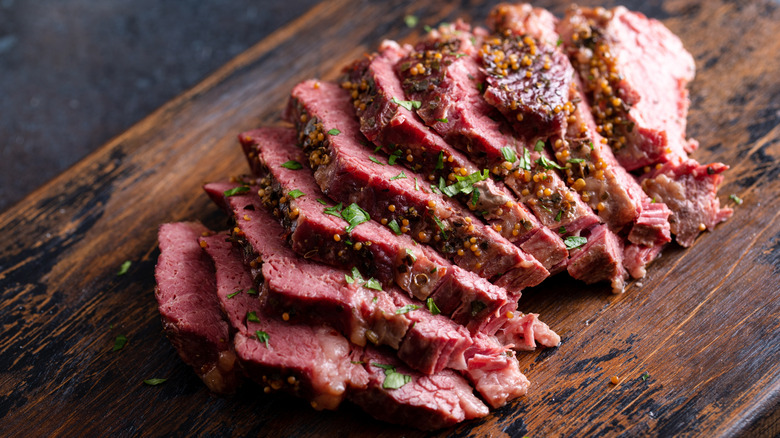
Elena Veselova/Shutterstock
Since 2020, sales of Spam and other canned meats have been on the rise. It's a trend that doesn't appear to be slowing down. Spam, Vienna sausages, Libby's corned beef, and Chef Boyardee meatballs are among the products flying off shelves, largely due to inflation and cost of living increases.
Rather than being seen as a slightly amusing retro product, Spam is now an everyday grocery staple for many households. That's not a bad thing — you can find all kinds of unexpected ways to use Spam, such as in hot pots, fried rice, pasta, and soup. Other canned meats, including hot dogs and Vienna sausages, can also be leveled up in ways you might not expect; just because you're cutting costs by using meat from a tin, it doesn't have to be a boring or lackluster meal. That said, highly processed meat does come with health concerns. Eating it regularly over a long period of time can lead to an increased risk of serious conditions such as heart disease and cancer. If it's something you're eating more of because of rising food prices, you might want to mix it up with alternative forms of protein, such as beans and other legumes.
Pickles
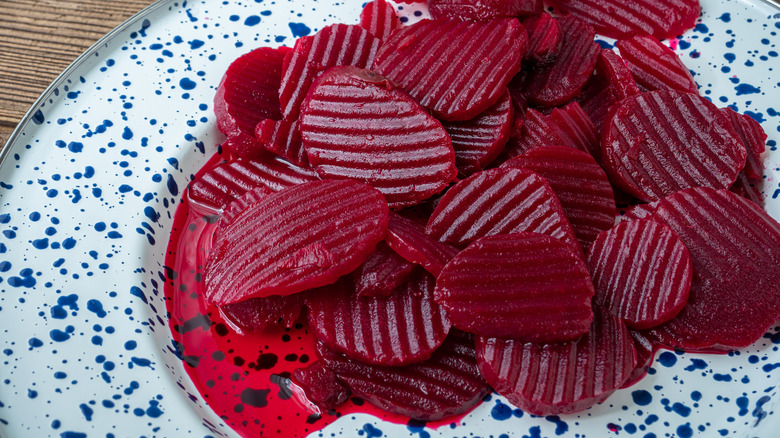
Lubos Chlubny/Shutterstock
The market for pickles has been steadily growing for the last few years. The classic dill pickle has always been popular, but there are other types of pickled vegetables that have more of a vintage edge. Pickled beets, radishes, and cauliflower are among those that seem tied to the past, but they're all included in this pickle resurgence.
Pickled vegetables have long been a way to stretch produce further. Packing fresh veggies in brine or vinegar was a way of preserving it to last through the bleak winter months when little grows. These days, we can get fresh produce from the store year-round, but it's still helpful to have items that can sit for a few weeks in the fridge (or last months unopened in a pantry). This can save money by cutting out some food waste. Buying fancy pickles can also be a small way for folks to treat themselves when they can't afford bigger luxuries. They can add some much needed tang to otherwise bland dinners, quickly and easily leveling them up.
Bouillon powder and stock cubes

Michelle Lee Photography/Getty Images
Another grocery trend is for bouillon powder and stock cubes. Sales for these products have gone up, even though they seem like a vintage relic you might find languishing at the back of your grandma's pantry. But, with hiking grocery prices, people are shying away from pricier liquid stocks and broths and focusing on the cheaper powdered versions instead.
Sales may also be on the up as more people are aiming to save money by cooking from scratch. Rather than eating out, ordering in, or buying high-end prepared food, folks are making the kinds of dishes that need bouillon. Some manufacturers have attempted wider appeals by making versions of their classic bouillon powders and stock cubes that appeal to a health-conscious audience. Organic, GMO-free, and salt-free offerings are all becoming more widely available. You can also find a wider range of flavors these days. Pad Thai stock cubes, mushroom bouillon, and red wine stock powder all appeal to those who don't necessarily want the classic flavor profile. Plus, vegetarian and vegan chicken and beef stock is a great selling point for those looking to make meat-free meals.
Condensed milk

Ws Studio/Getty Images
An increased interest in long-life dairy products since inflation hit may contribute to the rising sales of condensed milk. This vintage staple is more popular than ever, perhaps as people look for more shelf-stable products to avoid waste and bring the cost of their groceries down. Another reason why condensed milk might be increasing in popularity as inflation rises is that more people are making food at home.
Condensed milk is a surprisingly versatile ingredient that's used in a range of desserts, but it can also level up savory dishes. You can use it to make more flavorful carnitas, for instance. It's a popular addition to many holiday baking recipes, and it's likely that folks are baking more from scratch due to having less money to spend on luxuries at the store. If you want to incorporate more of this old school ingredient into your cooking, be mindful of the mistakes everyone makes with condensed milk. Some people confuse it with evaporated milk, which is an entirely different product. Others ignore some of its delicious uses, such as in dulce de leche recipes or eaten straight up on bread.
Powdered milk
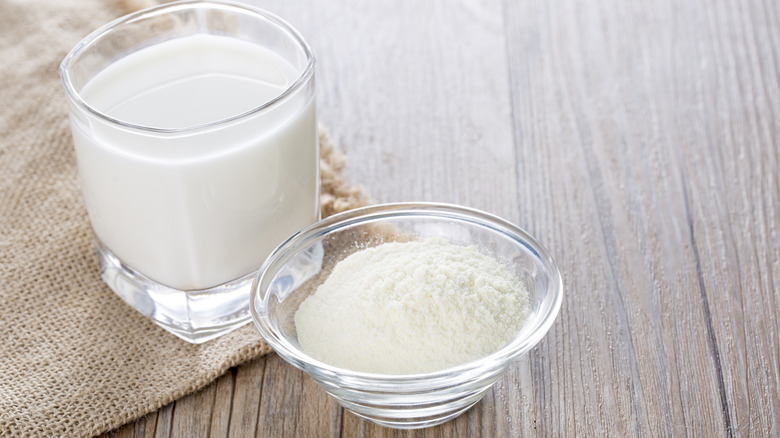
Ddukang/Getty Images
While condensed milk is a fun type of long-life milk, powdered milk is a more pragmatic one. Those feeling the pinch of inflation are looking to cut costs and once luxuries are all gone, it's time to try and save where you can on everyday essentials. It's also a sensible product for people who live alone and find that they don't get through a carton of milk before it goes bad. As such, the market has grown by billions in the last few years, and it's only predicted to rise more. Powdered milk isn't anyone's favorite, so it's likely gained popularity because it's cheap.
That said, it's not purely a cheap ingredient people use to save money. It's a pantry staple that you can use in teas, coffees, and it's great for baking in a pinch. It can make baked goods more flavorful and improve texture, giving you fluffier cakes and chewier cookies. Sure, it's not the most exciting of ingredients, but there might be more room in your pantry for powdered milk than you imagined.
Baking ingredients
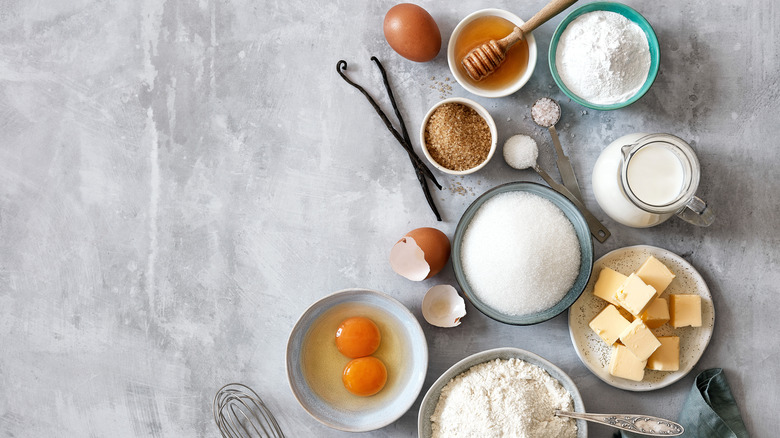
Baibaz/Getty Images
Baking often feels like an old fashioned pursuit. Of course, there are people who love baking today, but the idea that someone might have a perpetually stocked cake tin seems like something from a bygone era. However, sales of baking staples and baking mixes continue to increase, and have done so since the start of the COVID-19 pandemic — which is arguably when people really started to feel the hit of inflation on food prices.
With quality baked goods unaffordable for many, it's unsurprising that people are choosing to bake from scratch more regularly. Why spend $10 on a cardamom bun from a trendy bakery when you could learn to make them yourself, saving money and cultivating an enjoyable hobby. For those who don't have the time or energy to bake from scratch, baking mixes still save money compared to buying treats from a bakery. If you're not sure where to start, begin with easy dessert recipes for people who don't bake. You can always work your way up to more challenging recipes from there. Before you know it, you'll be whipping up croissants or perfecting your focaccia recipe. Baking isn't just about saving money, but it's always nice to know you spent less and ended up with something even better.



